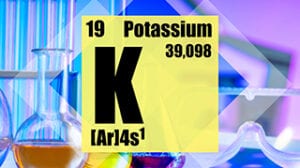 Potassium-ion batteries (KIBs) could be an attractive alternative to lithium-ion and sodium-ion batteries, but anode instability and flammability issues have so far held back progress.
Potassium-ion batteries (KIBs) could be an attractive alternative to lithium-ion and sodium-ion batteries, but anode instability and flammability issues have so far held back progress.
Now, four teams of scientists have released cutting edge research showing how tin could stabilise KIB anodes.
In Beijing, researchers created tin-sulphur nano-scale sheets for use in KIB anodes. The material allowed fast transmission channels for potassium ions during battery charge and discharge, while volume-expansion issues were avoided.
Across the country in Xi’an, another team discovered a new method to produce tin nanoparticles a thousand times smaller than the width of a human hair. When combined with carbon in an anode, the material outperformed other, previously investigated, tin-based materials for KIBs.
A team in Taiwan investigated tin nanoparticle shape. Scientists grew tiny tin-phosphorous (SnP0.94) teardrops in the lab; usually these nanoparticles would be more spherical. In an anode, the teardrops showed superior reversible capacity and excellent structural stability. When combined with a cathode, the resulting cell had a lifetime of up to 450 cycles.
Lastly, a group in Tokyo used computer simulations to compare the performance of potassium-phosphorous anodes and potassium-tin anodes. The tin-containing option was faster at releasing energy, while the phosphorous anode was able to store more energy. The team concluded both anodes could: “perform in a range that is acceptable for use in energy storage applications”.
KIBs are an attractive alternative to both lithium and sodium-ion batteries. On one hand, lithium metal is relatively rare and unevenly distributed. Meanwhile, sodium-ion batteries are limited by their energy density, making them poor candidates for applications such as electric vehicles. In theory, KIBs could have an energy density close to that of lithium-ion batteries while at the same time potassium is super abundant, making up 2% of the Earth’s crust.
However, safety issues hold back KIB development. Potassium is highly reactive, with the batteries potentially experiencing so-called “thermal runaway” at lower temperatures than both sodium-ion and lithium-ion batteries. Potassium-ions are also larger than lithium and sodium. When these large, spherical ions insert themselves into tin-based anodes during charging, the anode has been seen to expand by 681%, much more than for other battery types. This expansion could cause the anode to pulverize and break down, ultimately cutting short the KIB lifetime.
Our view: KIBs have long been side-stepped in favour of lithium and sodium alternatives, despite their theoretically high energy storage potential. Adding tin to a graphite KIB anode could indeed be a significant step forward. However, KIBs have a long road to commercial viability. Vilas Pol, professor of chemical engineering at Purdue University, says: “It will take time to figure out the exact combination of electrolyte, cathode, and anode…It might take another 15 years from now to get to the market.”
Peking University, Beijing – Research Paper, April 2021
Xi’an Jiaotong University, Xi’an – Research Paper, May 2021
National Tsing Hua University, Taiwan – Research Paper, August 2021
University of Tokyo, Japan – Research Paper, March 2021
< Back to Post Lithium Ion Batteries
< Back to New Technologies


